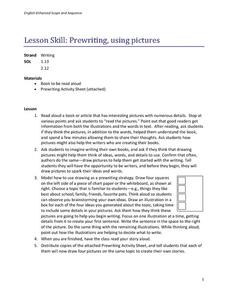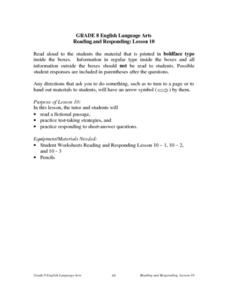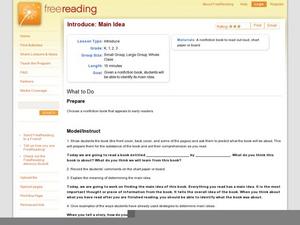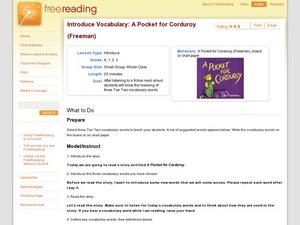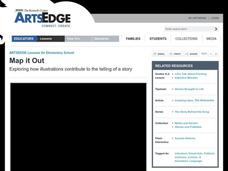Curated OER
Prewriting, Using Pictures
Young readers practice getting information from both the text and the illustrations found in books they are reading. They see that quite often, authors use pictures to help them get their writing process started. Youngsters are invited...
Curated OER
We All Need Speed Limits
Students consider fluency and speed of reading. In this speed limits lesson, students discuss the importance of speed when reading and how the rate affects comprehension and listening skills. Teacher models think aloud as a strategy.
Curated OER
Reading and Responding -- Lesson 10
Fourth graders work individually or in a small group to (1) read a fictional passage, (2) practice test-taking strategies, and (3) practice using context clues to increase their vocabulary. Reading passage and comprehension questions...
Curated OER
Is this the right book for me?
Sixth graders recognize strategies for selecting nonfiction texts. In this book selection lesson, 6th graders practice procedures for knowing if the book is just right for them. Students select from a variety of texts and share their...
Virginia Department of Education
Identifying the Main Idea in Fiction
Discovering the main idea in fiction is like uncovering buried treasure; one must persevere to locate it, and the reward is priceless. Scholars delve deep into leveled stories using three questions to aid in identifying the main idea.
Curated OER
Introduce Vocabulary: A Picture Book of Helen Keller (Adler)
The story of Helen Keller is a fascinating one for young scholars; use it to practice reading comprehension and new vocabulary as learners listen to you read David Adler's picture book (hint: this strategy can be applied to any book)....
Curated OER
Introduce Vocabulary: How Do Dinosaurs Say Goodnight? (Yolen and Teague)
If you are reading Jane Yolen's fun story How Do Dinosaurs Say Goodnight?, use these strategies to enhance the experience for budding readers. What new words will they learn? Find detailed comprehension questions for these in-text words:...
Federal Trade Commission
Ad Targeting and Techniques
What techniques do advertisers use to reach a target audience? Pupils discover the answer with the second of four Admongo lesson plans. Scholars learn about the most common strategies advertisers use to convince people to buy something....
Curated OER
Introduce: Main Idea
Begin exploring main idea in a text by telling the class an interesting story. Can they recall the main idea after you finish? What clues told them this was it? Explain that you will apply this concept as you read a nonfiction book....
Curated OER
Introduce Vocabulary: Clouds (Bauer)
What type of cloud is that? Explore meteorological vocabulary using Marion Bauer's book, Clouds (although these strategies could be used for any fiction or nonfiction text). Pre-teach the new words before reading the story aloud....
Curated OER
Introduce Vocabulary: A Pocket for Corduroy (Freeman)
Who doesn't love this book? A Pocket for Corduroy provides excellent vocabulary practice in context for budding readers (although this strategy could be used with any text). Before reading it aloud, go over the new terms: affectionate,...
Curated OER
Introduce Vocabulary: Airport (Barton)
This vocabulary-in-context strategy can be applied to any book that learners read with you; however the activity here is designed around Byron Byrton's fiction book, Airplane. First, introduce the new words you will learn: attendant,...
Curated OER
Introducing Vocabulary: Christopher Columbus (Weinberger)
The story of Christopher Columbus has fascinated young historians for centuries; use this vocabulary-in-context strategy to dive into Kimberly Weinberger's picture book about this classic explorer. Begin by introducing the new words:...
Curated OER
Introduce Vocabulary: Cloudy with a Chance of Meatballs (Barrett)
Although this vocabulary strategy would work in the context of any text, it's a piece of cake if you're reading Judi Barrett's book Cloudy with a Chance of Meatballs. Go over the terms they will hear so pupils are ready to raise their...
Curated OER
Introduce Vocabulary: Make Way for Ducklings (McCloskey)
Use the Caldecott Award-winning book Make Way for Ducklings by Robert McCloskey (which can be found on YouTube if you don't have it) to guide budding readers through vocabulary in context. Although the instruction here is limited to the...
Curated OER
Map It Out
Explore how illustrations add to a story. Young learners will look at picture books to see how the pictures tell the story. They create illustrations to go with a chosen story, and then flip the activity so they have to write a story to...
Curated OER
Introduce Vocabulary: Alexander, Who Use to be Rich Last Sunday (Viorst)
Although this vocabulary-in-context activity is focused on Judith Viorst's book Alexander, Who Use to Be Rich Last Sunday, the strategy can be applied to any book budding learners read with you. First, introduce the three new words you...
Curated OER
Introduce Vocabulary: Bringing the Rain to Kapiti Plain (Aardema)
The African plains come alive as scholars learn vocabulary in context through Verna Aardema's story Bringing the Rain to Kapiti Plain (tip: this strategy can be applied to any book). Precede reading by introducing the new words pupils...
Curated OER
Getting to Know You
After going over the five steps of the writing process, pupils fill out "Getting to Know You" worksheets. They trade papers with each other, and have the task of writing a descriptive paragraph about the person whose worksheet they...
Curated OER
Build Masters: Identifying Details
Find key details in books using this note card strategy. Each reader gets six cards with the classic who, what, where, when, why, and how detail prompts. After they read the book, they choose a card and locate a key detail answering the...
Virginia Department of Education
Identifying Audience and Purpose
Use a fun and creative activity to introduce junior high learners to how writing changes for different audiences and purposes. The activity begins with a reading by the instructor where teens visualize a food fight in the cafeteria. In...
EngageNY
Forming a Research-Based Claim: Comparing Cascading Consequences
It's time to weigh the risks and benefits of screen time! Pupils work in triads to identify the strongest positive and negative consequences from their Cascading Consequences chart. Next, using the chart and their researcher's notebooks,...
Curated OER
Read Aloud- Literary Elements- Prediction
First graders read two stories. In this literary elements lesson, 1st graders read The Hat by Jan Brett, notice patterns of prediction, identify the setting, problem and solution and compare the story to the book The Mitten.
Scholastic
Ask the Author
Here is a quick activity that could help your kids with their reading comprehension. They practice a classic strategy that gets them to start asking questions about what they are reading, while they are reading it. They write out...


